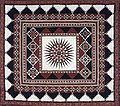- Crazy quilting
-
The term "crazy quilting" is often used to refer to the textile art of crazy patchwork and is sometimes used interchangeably with that term. Crazy quilting does not actually refer to a specific kind of quilting (the needlework which binds two or more layers of fabric together), but a specific kind of patchwork. Crazy quilts rarely have the internal layer of batting that is part of what defines quilting as a textile technique.
Contents
Combining the patches
Regular patchwork combines the pieces of fabric into a predetermined and regular design, but crazy patchwork uses irregular pieces of fabric on a foundation fabric or paper. This may create haphazard-looking and asymmetrical designs, or the designer may use some control in placement.
Patches can be hand appliquéd onto a base fabric. This method gives the most variety as every patch is unique. There are also block patterns designed for crazy quilt that can be sewn by machine.
Sometimes part of a crazy quilt is haphazard while other parts are placed in a planned pattern. A common example of this the placement of patches is a fan pattern.
The patches and seams are then usually heavily embellished.
Embellishing
Crazy quilts differ from "regular" quilts in other ways as well. Because the careful geometric design of a quilt block is much less important in crazy quilts, the quilters are able to employ much smaller and more irregularly-shaped pieces of fabric. In comparison to standard quilts, crazy quilts are far more likely to use exotic pieces of fabric, such as velvet, satin, tulle, or silk, and embellishments such as buttons, lace, ribbons, beads, or embroidery. Crazy quilting as a textile art is extremely creative and free-flowing by nature, and crazy quilters will often learn as much about specific embellishments as they will about crazy quilting itself.
History
 Crazy quilt held at the Birmingham Museum of Art
Crazy quilt held at the Birmingham Museum of Art
Crazy quilting created a stir in the 1880's when it became quite a fad in the United States. The Japanese Exhibit in the 1876 Philadelphia Centennial Exposition inspired the crazy quilt with its asymmetrical art.
Articles encouraging crazy quilting, or condemning it, could be found in women's publications. Women could purchase packages of random fabrics, as well as already embellished pieces, to use in their own crazy quilts.
During the first several years of the crazy quilting fad, fine fabrics and heavy embellishment were the norm. As time passed quilters began to make simpler quilts in the crazy quilt style. Thrifty housewives used everyday fabrics like wool or cotton and little or no embellishment to create more serviceable quilts than the original fancy crazy quilts with the added benefit of using up small or odd-shaped scraps left over from making clothing for the family or other household sewing projects.
External links
Examples of ways of combining patches in a crazy quilt:
Learn more about crazy quilt history.
An example of a crazy quilt from the Smithsonian.
Modern crazy quilting
Sources
- 2008: Cindy Brick. Crazy Quilts: History, Techniques, Embroidery Motifs, Voyageur Press. ISBN 13-978076033-237-5
- 2000: Christine Dabbs. Crazy Quilting: Heirloom Quilts: Traditional Motifs and Decorative Stitches,Rutledge Hill Press. ISBN 1-55853-694-9.
- 1995: Judith Baker Montano. Elegant Stitches: An Illustrated Stitch Guide and Source Book of Inspiration, C&T Publishing. ISBN 0-914881-85-X.
Layered textiles Quilting Baltimore album · Corded quilting · Crazy quilting · Foundation piecing · Hawaiian quilt · Nakshi Kantha · Patchwork quilt · Provençal quilts · Quilt art · Quilting · Quilts · Ralli quilt · Sashiko quilting · TrapuntoPatchwork Applique History & works People Sandy Bonsib · Jo Budd · Jennifer Chiaverini · Mimi Dietrich · Harriet Powers · Holice Turnbow · Marie WebsterOrganizations, Museums & Events Great Lakes Quilt Center · International Quilt Study Center · Museum of the American Quilter's Society · Quilt Index · Quilters Hall of Fame · Quilt National · Quilt Treasures · San Jose Museum of Quilts & TextilesCategories:
Wikimedia Foundation. 2010.


